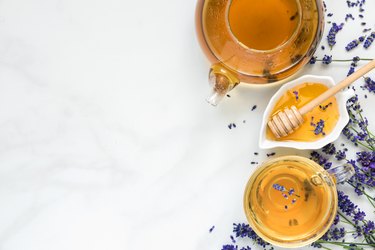
Delicately-fragrant lavender is believed to serve as a sleep aid, and is taken in various forms to help with anxiety and pain. These uses have not yet been backed by science. There are several varieties of lavender; dried English lavender leaves are preferred for making lavender tea.
Tip
Although not medically proven, lavender is believed to have medicinal uses as a healing aid for pain, anxiety, depression, intestinal problems and sleep issues.
Video of the Day
Lavender plants are native to the Mediterranean, the Arabian Peninsula and Russia and are grown in Europe, the U.S. and Australia. Lavender is taken as a dietary supplement for anxiety, depression, intestinal problems and pain. It also has topical applications, and is extracted as an essential oil.
Video of the Day
Lavender Tea Benefits
Lavender tea is made by steeping the dried leaves of English lavender in boiling water to make a tisane (herbal tea). Lavender tea is also sold commercially, often in combination with chamomile, another herb that is believed to have medicinal and soothing qualities.
A December, 2015 study conducted in Taiwan on 80 women evaluated the effectiveness of lavender tea for relieving poor sleep quality, fatigue and depression and for improving maternal-infant attachment during the early postpartum period. Study participants drank one cup of lavender tea a day, for two weeks, and were instructed to take time to "appreciate the aroma" of the tea before consuming it.
Half of the participants reported experiencing less fatigue and depression, and greater bonding with their infant, as compared with the control group. However, results for all participants were similar at four weeks, with researchers suggesting that the positive impact of lavender tea appeared limited to the immediate-term.
Lavender Uses
In addition to lavender tea, the lavender plant has other uses. In cooking, lavender flowers can be incorporated either whole, or cooked into a simple syrup. English lavender, in particular, is good for flavoring cakes, ice cream, jams, meat rubs and pastries.
Lavender flowers are also used in potpourri and sachets, and the leaves are distilled for their oils. Lavender's first documented use was by the Romans in 77 A.D., for insect bites and to repel insects.
As an essential oil, herbalists consider lavender one of the most important for therapeutic uses and healing, such as for wounds and burns. It is also used in aromatherapy and in many lotions, bath products and perfumes. According to the Mayo Clinic, aromatherapy is thought to work by stimulating smell receptors in the nose, which then send messages through the nervous system to the limbic system, the part of the brain that controls emotions.
A May 2017 article published in Frontiers in Pharmacology notes that lavender essential oil is traditionally used and approved by the European Medicines Agency (EMA) as herbal medicine to relieve stress and anxiety. Studies are inconclusive as to lavender's positive effect on the nervous system, but it remains popular as an aromatherapy treatment.
Lavender Tea Side Effects
Much of the research on lavender has been focused on tropical application rather than on its use in tea. Diluted lavender oil is generally considered safe for most adults, but some reports suggest that it can cause skin irritation. Large quantities taken orally can be poisonous, and lavender extracts may cause stomach upset, joint pain or headaches. The effects of inhaling lavender oil are not known.
If you drink lavender tea that has been combined with chamomile, be aware that chamomile may increase the anticoagulant properties of blood-thinning medications like warfarin (Coumadin) or clopidogrel (Plavix).
Like lavender, chamomile is taken as a tea, and in other oral formulations, for various digestive disorders including indigestion, nausea, vomiting, loss of appetite and intestinal gas. Though not scientifically proven to be effective, chamomile is used topically on the skin for pain and swelling, and is included in ointments, creams, and gels.
Chamomile may cause an allergic reaction in people who are sensitive to the Asteraceae/Compositae family of plants, which include include ragweed, chrysanthemums, marigolds and daisies.
- NIH National Center for Integrative Health: "Lavender"
- Frontiers in Pharmacology: "Exploring Pharmacological Mechanisms of Lavender (Lavandula angustifolia) Essential Oil on Central Nervous System Targets"
- Mayo Clinic: "What Are the Benefits of Aromatherapy?"
- Worldviews on Evidence-Based Nursing: "Effects of Lavender Tea on Fatigue, Depression, and Maternal-Infant Attachment in Sleep-Disturbed Postnatal Women"
- Harvard Health Publishing: "Is There a Natural Remedy for Anxiety?"
- University of Vermont Extension, Department of Plant and Soil Sciences: "Growing and Using Lavender"
- U.S. National Library of Medicine: "Roman Chamomile"
- University of Arkansas Division of Agriculture Research & Extension: "Plant of the Week: Lavender, English"